Owls in Ohio
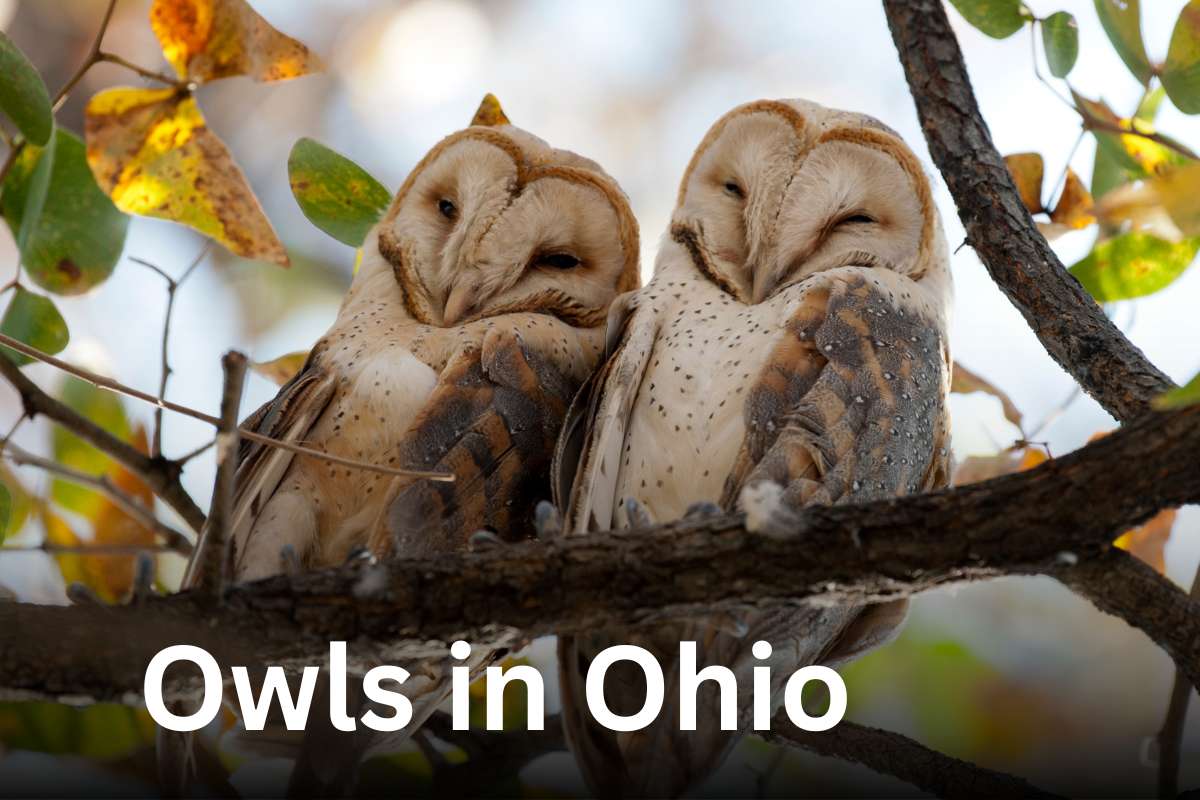
Ohio is a state that lies in the midwestern region of the United States. It is a state that is covered with beautiful fascinating creatures. There have been several species of birds that are found in the United States of Ohio.
As mentioned in the Ohio Bird Records Committee (OBRC), there were around 450 species on the official list, as of December 2023. It is home to a diverse array of majestic owl species.
Owls are found in all regions of the Earth. However, they do not live in the polar ice caps and some remote islands. Owls as nocturnal predators have grabbed the attention of many bird watchers for centuries.
In the following blog post, we will explore the top eight owls in the state of Ohio. So, let us go through this article.
List of Owls in Ohio
- Barn Owl
- Great Horned Owl
- Short-eared Owl
- Barred Owl
- Snowy Owl
- Long-eared Owl
- Eastern Screech Owl
- Northern Saw-whet Owl
1. Barn Owl (Tyto alba)
Scientifically, the barn owl‘s name is Tyto alba. Commonly, this species of owl is also known as the death owl, ghost owl, lich owl, and demon owl. It belongs to the family of Tytonidae.
Generally, the barn owl’s face is heart-shaped which is bright white and its eyes are black. It is a pale-colored owl whose head and upper body are pale brown and somewhat grey.
The plumages on the back are mottled shades of grey or brown with a short squarish tail along with long wings.

These nocturnal owls have another distinguishable characteristic, the undulating flight pattern and the dangling, feathered legs. Its name is similar to a barred owl. But, the appearance of the barred owl is quite different.
Size, Weight, Wingspan, and Lifespan of Barn Owl:
- Size: 13 to 15 inches (13 to 15 in)
- Weight: 9.2 oz (260 g)
- Wingspan: 31 to 37 inches (80 to 95 cm)
- Lifespan: four years
Due to the lack of nesting sites, the barn owl populations are declining rapidly. But, if the nest boxes are managed properly then they can also expand their population rapidly.
As per the IUCN (International Union for Conservation of Nature), globally this owl is listed as the least conservation concern.
Habitat: Widely, it is spread all over the world except in the polar regions and desert regions. The Barn owls live in open areas, farmlands, cities, and forest edges.
Recently, these owls were spotted in New Zealand and Kauai (an island of Hawaiian) in the late 2000s. It is rarely found in Ohio. They do not hoot but, the male barn owls make a long harsh scream call that lasts for about two seconds.
Most often the owls range from the Pacific Islands, Europe (except Fennoscandia and Malta), North America, South America, and Central America.
Feeding: The barn owl is also known as the common barn owl. It is a medium-sized carnivorous animal. These owls are active during the night or in the twilight period.
Depending upon its size, the barn owls prefer to eat more rodents. Also, 90% of their diet comprises rodents and small mammals.
However, their second main source of food comes from shrews, small birds, amphibians, fish, spiders, and insects.
The metabolic rate of this owl is higher as compared with other species of owls found all over the world. It likes to haunt old buildings.
Due to their distinctive characteristic, the barn owl is considered one of the most economically valuable wildlife animals for agriculture.
Relatively, the farmers want to encourage these species of owl habitat to reduce rodent pests by providing them a nesting sites.
2. Great Horned Owl (Bubo virginianus)
Generally, the great-horned owl has a facial disc. It is a large-sized owl that belongs to the family of Strigidae. Commonly, this species of owl is also known as tiger of the air, tiger owl, hoot owl, and winged tiger.
This owl can rest in the tall-thin position, where it holds themselves as slim and sits erect as it becomes possible. It has variable white patches on its throat side and the bill is dark gunmetal-gray.

The upper parts and upper wings of this owl are mottled brown, its feathered legs and feet are black, and its eyes are cylindrical. It also has asymmetrical ear holes that help to know while they are hunting in the dark.
Also, their tuft of feathers are called plumicorns. Being one of the species of owl, it shows much of its camouflage color.
Size, Weight, Wingspan, Bill, and Lifespan of Great Horned Owl:
- Size: 17 to 25 inches (43 to 64 cm)
- Weight of male: 3.545 lbs (1,608 g)
- Weight of female: 2.698 lbs (1,224 g)
- Wingspan: 22 inches (55 cm)
- Bill: 1.3–2.0 inches (3.3–5.2 cm)
- Lifespan: 20 to 30 years
According to the International Union for Conservation of Nature (IUCN), the conservation status of the great horned owl is the least concerned.
Habitat: The great horned owl is generally seen in open woodland, grasslands, forests, backyards, cities, deserts, and wetlands. Throughout the year, they prefer to live in pine and coniferous trees.
In Northeastern Ohio, the great horned owl is recognized as one of the most powerful common owls. This owl is the second most widely distributed in America right after the Barn Owl.
Feeding: These species of owls are more vulnerable to hunting their prey during daylight in the afternoon. It preys on other predators such as birds, mammals, amphibians, and reptiles.
Primarily, the great horned owl’s diet consists of insects, crustaceans, carrion, mice, rodents, rats, rabbits, hares, voles, and porcupines.
3. Short-eared Owl (Asio flammeus)
The distinctive physical feature of a short-eared owl is a medium-sized brown owl. This eared owl belongs to the family of Strigidae which possesses a big rounded head, broad wings, and a short neck.
The plumage of this eared owl is mottled tawny to brown with a whitish disk and its bill is strong, short, hooked, and black. Overall, its body is heavily streaked with dark patches near the eyes.
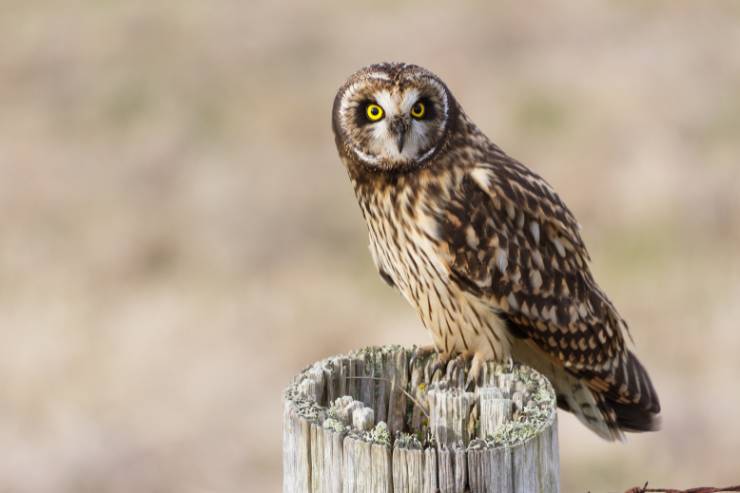
The facial appearance of this owl is white, and its ear tufts may or might not be visible because of its tiny size. At the time of the flight, its structure is similar to moth or bat-like.
Size, Weight, Wingspan, and Lifespan of Short-eared Owl:
- Size: 13–17 inches (34–43 cm)
- Weight: 7.3–16.8 ounces (206–475 g)
- Wingspan: 33 to 43 inches (85 to 110 cm)
- Lifespan: 12 years
The conservation status of the short-eared owl is the least concern, as evaluated by the International Union for Conservation of Nature (IUCN). However, this species of owl is listed as endangered in New Mexico.
Habitat: Typically, this owl is found in open country areas with dense wooded thickets, marshes, grasslands, tundra, prairies, and dunes.
It is a partially migratory owl that often ranges from the northern parts and southern parts in winter. They are often spotted in Asia, North America, South America, Europe, Hawaii, and the Galapagos Islands.
Feeding: It is a crepuscular and diurnal owl that hunts its prey mostly at the time of night. Their main diet consists of rodents (especially voles), mammals like rabbits, rats, shrews, muskrats, and ground squirrels.
In addition, this owl also preys the avian birds like beetles, roaches, grasshoppers, katydids, icterids, and tyrant.
4. Barred Owl (Strix varia)
Commonly, the barred owl is also known as the hoot owl, eight-hooter owl, and striped owl. The physical appearance of this owl is greyish-brown or brown.
Its facial disc is pale grayish-brown and its bill is pale straw-yellow. The barred owl is fairly large, has dark eyes and its upper parts are brown with mottling.

Size, Weight, Wingspan, and Lifespan of Barred Owl:
- Size: 16 to 25 inches (40 to 63 cm)
- Weight of male: 1.032 to 1.790 lbs (468 to 812 g)
- Weight of female: 1.34 to 2.54 lbs (610 to 1,150 g)
- Wingspan: 38 to 49 inches (96 to 125 cm)
- Lifespan: 8 years
As per the International Union for Conservation of Nature (IUCN), the barred owl is classified as Least Concern.
Habitat: The barred owl also known as the eight-hooter owl is largely found in mixed forests, deciduous forests, and occasionally in coniferous forests. This owl is considered to be one of the most common owls in Ohio.
It is also found in upland wooded habitats, mixed swamp areas, semi-open wooded areas, and suburban areas. They are distributed widely throughout southern Canada, Quebec, Minnesota, the eastern United States, and Nova Scotia.
Feeding: The Barred owls are known as an opportunistic predator. Its primary diet consists of small mammals, birds, reptiles, amphibians, and a variety of invertebrates.
5. Snowy Owl (Bubo Scandiacus)
The Snowy owls are often known as Arctic owls, Polar owls, and White owls. These owls are large and are a true owl family. Its distinctive features are regarded as one of the largest species of owl.
It is an owl that has mainly white plumage. The upper parts of adult male owls are plain white with a few dark spots on the miniature ear-tufts. Whereas, its underparts are pure white.
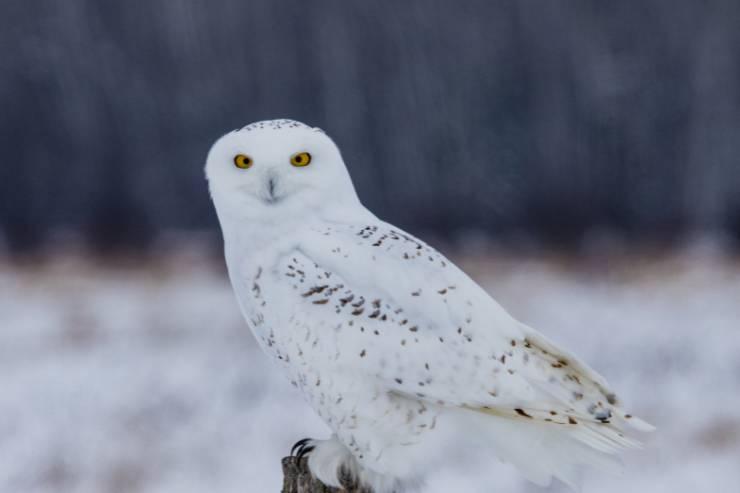
Likewise, adult females and immature owls are usually white with darker barring.
Size, Weight, Wingspan, Ear Tufts, and Lifespan of Snowy Owl:
- Size: 52–71 cm (20.5–27.9 inches)
- Weight: 1600–2950 grams (56.4–104.1 oz)
- Wingspan: 126–145 cm (49.6–57.1 inches)
- Lifespan: 10 years
The average lifespan of a snowy owl in the wild is 10 years whereas its captivity is nearly 28 years. The conservation status of the snowy owls is classified as endangered.
As of now, the population of these owls is declining and is listed as “vulnerable” to global extinction.
Habitat: Typically, the snowy owl is found in the northern circumpolar region, in broad, and treeless tundra. Besides they are usually found perching on the ground.
Primarily, they range in some parts of northern Russia, North America, northern Alaska, northern Eurasia, northern Europe, and northern Canada.
Feeding: This owl can hunt their prey any time of the day or night. The snowy owls swallow the small prey wholly.
These owls are considered specialized and generalist hunters. Their diet consists of rabbits, birds, Arctic hares, ducks, seabirds, and fish.
6. Long-eared Owl (Asio otus)
The long-eared owl is also known as the northern long-eared owl, cat owl, or lesser horned owl. These species of owl are medium-sized covering a wide range of breeding habitats.
Adult owls have long-winged owls with prominent erectile ear tufts which are present at the center of the head. The coloration of this owl varies according to the hue of the ochraceous tawny with a grayish or brownish color.
The upper part of the breast has a dusky streak whereas the lower parts have variable blackish vertical streaks on their body.
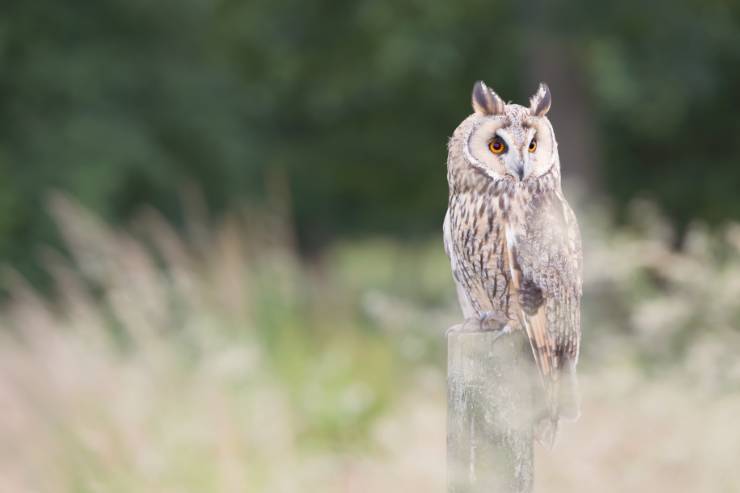
Relatively, the skull of this owl is big, but its yellow eyes and orbits are smaller. The beak size of the long-eared owl is long, elongated, and thin. They have an orangish facial disc.
Size, Weight, Wingspan, Bill, and Lifespan of Long-eared Owl:
- Size: 12 and 16 inches (31 and 40 cm)
- Weight: 220-435 g (7.8-15.3 oz)
- Wingspan: 2 ft 10 in to 3 ft 4 in (86 to 102 cm)
- Bill length of male owl: 0.62 inches (1.57 cm)
- Bill length of female owl: 0.64 inches (1.62 cm)
- Lifespan: 25 to 30 years
The oldest long-eared owl age was recorded to be at least 12 years and one month old. According to the IUCN Red List, the long-eared owl is assessed to be of least concern.
Habitat: This owl is partially found in semi-open areas such as woodland edges and conifer groves. Primarily, their habitat mostly prefers to roost and nest within dense stands of wood where they can hunt their prey on the open ground.
The long-eared owl is often observed in Ohio during the migration period and winter season. Widely, these owls are distributed in North America, Eurasia, Europe, western France, Georgia, and southern Ontario.
But they aren’t found in Austria, Southeastern Europe, and Italy.
Feeding: It is a partial migratory owl. These species of owls are specialized predators who feed on small rodents and voles. The long-eared owl also eats other animals and small birds depending upon the region. Such as lizards, snakes, shrews, bats, and pocket gophers.
7. Eastern Screech Owl (Megascops asio)
Commonly, the eastern screech owl is also known as the eastern screech owl. It is a small-sized owl that is mostly found in Eastern North America.
This owl is stocky, short-tailed, and broad-winged. One of its most noticeable features is having a large round head with prominent ear tufts. It also has yellowish eyes and beaks.
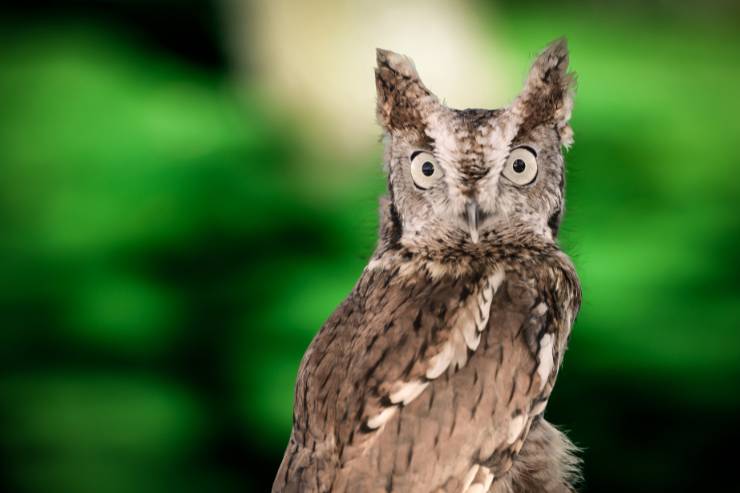
The eastern screech owl is regarded as one of the heaviest screech owls. It has been revealed that most of the bird watchers have observed this owl with two color variations. Such as red or rufous morphs and gray morphs.
Size, Weight, Wingspan, Bill, and Lifespan of Eastern Screech Owl:
- Size: 6.5 to 10 inches (16 to 25 cm)
- Weight: 121–244 g (4.3-8.6 oz)
- Wingspan: 18.9-24.0 in (48-61 cm)
- Bill: 1.45 cm
- Lifespan: three to seven years
The eastern screech owls are classified as least concern according to the IUCN Red List of Threatened Species.
Habitat: These species of owl inhabit open mixed woodlands, wooded suburban areas, riparian woods, parklands, marshes, meadows, and deciduous forests. They are found in North America, from Mexico to Canada.
Feeding: Eastern screech owl feeds primarily on crayfish, tadpoles, frogs, mammals, earthworms, birds, and lizards. Also, large insects are favored in their diet during the breeding season. In Ohio, some of the owls commonly store food items behind meadow voles.
8. Northern Saw-whet Owl (Aegolius acadicus)
It is a small species of owl that belongs to the family Strigidae. The northern saw-whet owl is recognized as one of the smallest owls in North America.
This owl has a porphyrin pigment in their flight feathers that exposes UV light. Their feather color is fluorescing neon pink. The adults have a small round head without ear tufts.
Its physical features include a white face with brown and cream streaks, dark beaks, and yellow eyes, and its juveniles have dark brown heads and wings. The upper parts are brown or reddish with white spots.
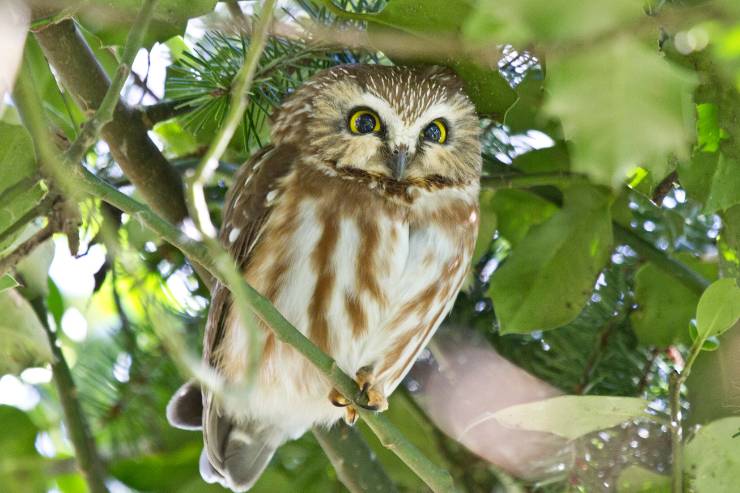
Likewise, the lower parts are pale with dark shaded areas. The northern saw-whet owl has a white Y-shaped coloration between its eyes.
Size, Weight, Wingspan, Bill, and Lifespan of Northern Saw-whet Owl:
- Size: 6.7–8.7 inches (17–22 cm)
- Weight: 1.9 to 5.3 ounces (54 to 151 g)
- Wingspan: 16.5–22.2 inches (42–56.3 cm)
- Bill: 8 inches
- Lifespan: seven years
This owl is classified as least concern by the IUCN Red List. The average lifespan of the northern saw-whet owl is seven years. However, the oldest owl was recorded to be at least nine years and five months old.
Habitat: The northern saw-whet owl breeding habitat mainly occurs in coniferous forests, mixed or deciduous forests, and riparian woods. It is found across North America, southern Canada, southcentral Alaska, central Mexico, and most parts of the United States.
Feeding: Their diet occasionally includes squirrels, mice, moles, bats, shrews, chickadees, kinglets, and sparrows. Its main diet consists of small rodents.
Conclusion:
In conclusion, Ohio is a state where different enigmatic birds of prey are found with their unique habitats and ecological roles.
From the barred owl to the northern saw-whet owl that exhibits both resilience and fragility.
Throughout the exploration of the avian world, we have uncovered the captivating presence of different species of owls within the state’s abundant wildlife.

